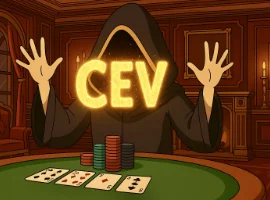As you've understood by now, ITM (In The Money) is one of the most important metrics in Spin & Go: if you're below a certain threshold, you're losing money in the long run — if you're above it, you're profitable.
However, Spin players generally don’t talk about their ITM percentage when analyzing their performance.
Instead, they prefer to use a metric called Chips EV, abbreviated as CEV.
The Chips EV (CEV), or “chip expectation”, represents the average number of chips you win per game, factoring out the variance caused by luck in all-in confrontations.
For example:
The minimum CEV required to be profitable can be calculated from the theoretical minimum ITM needed to break even (as explained in the previous chapter). Let’s take the example of Betclic, where an ITM of 35.9% is required to be profitable:
Assume there are 1500 chips in play per game, with each player starting with 500 chips (which is the standard setup in regular Spins). The calculation of the minimum required CEV is as follows:

With an ITM of 35.9% and a total of 1500 chips in play, we get:

This means you would need a CEV of 38.5 to be profitable on Betclic—in other words, you need to win an average of 38.5 chips per game.
CEV is automatically calculated by your poker tracker (an essential tool for any Spin player). We’ll cover trackers in more detail later, but just know that they provide valuable statistics (including your CEV) to help you track your long-term performance.

We can calculate this player’s CEV by dividing the Net Expected Chips Won by the number of games. That gives 320,000 / 4,710, which is a CEV of approximately 68.
Note that the tracker displays two curves: Net Expected Chips Won (in yellow 🟨) and Chips Won (in green 🟩).
You should use Net Expected Chips Won to calculate CEV.
Chips Won 🟩 shows the chips you actually won, while Net Expected Chips Won 🟨 calculates the chips you should have won based on your winning probabilities every time you went all-in.
This is a crucial question.
Imagine you play 100 Spin & Go games. You open your tracker and see a CEV of 130.
Are you a poker genius?
Conversely, you play 100 games and see a CEV of -20... Are you really that bad?
The "simple" answer is: you can’t really tell, because 100 games is not enough to reliably determine your CEV.

Swongsim is a tool that can help us illustrate this concept.
Let’s assume you’re a solid player with a real CEV of 60 — a strong CEV that’s more than enough to be profitable in Spin & Go, as we’ve seen in the previous chapters.
We’ll simulate 100 sessions with Swongsim to see the actual CEV you might end up with after just 100 games.
Here’s what we get — it looks complex, but don’t worry, I’ll explain!

Each line above represents 100 games played — and there are 100 lines total. It’s as if we simulated you playing 100 games, 100 different times, and recorded the resulting CEV each time.
You’ll notice that even though your real CEV is 60, there’s a 5% chance you end up with a CEV lower than 4.9 after 100 games.
On the flip side, there’s also a 5% chance you end up with a CEV higher than 126.9 — just by playing the exact same 100 games.
What if we repeat the test over 1,000 games?
Let’s do the same simulation for 1,000 games:

This time, the lines are closer together, and all tend to converge toward a CEV close to 60.
And over 10,000 games?

Now we can see that after 10,000 games, it’s very unlikely that your tracker’s CEV will be far off from your actual CEV — and therefore, your true skill level.
Conclusion: You need to play at least 1,000 games to get a reasonably accurate idea of your CEV — and thus, whether you’re truly a winning player or not.
There’s a direct relationship between your theoretical ITM and your CEV.For example, 40% ITM corresponds to a CEV of 100.
In Spin & Go, CEV is an excellent metric to measure a player's skill level.It’s a bit like the ELO rating in chess, as it directly reflects your skill — and therefore the profitability of your sessions.
Knowing your CEV is essential, as it gives you an objective measure of whether you are a winning or losing player in the long run.
However, you need to play a large enough sample (more than 1,000 games) to know your true CEV with any real accuracy.













